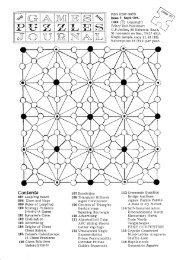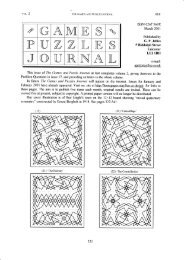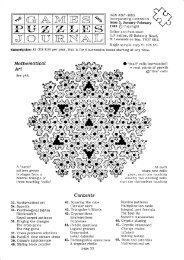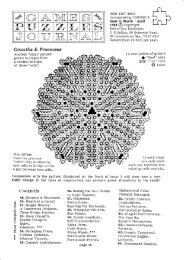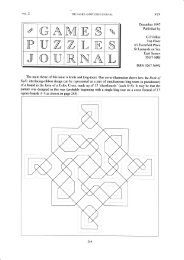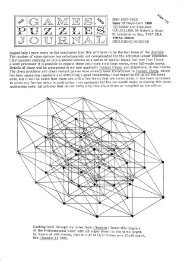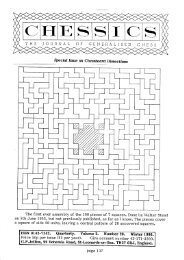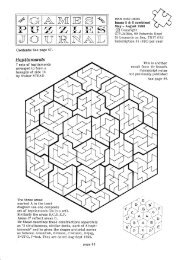The Games and Puzzles Journal, #8+9 - Mayhematics
The Games and Puzzles Journal, #8+9 - Mayhematics
The Games and Puzzles Journal, #8+9 - Mayhematics
Create successful ePaper yourself
Turn your PDF publications into a flip-book with our unique Google optimized e-Paper software.
page L44<br />
THE GAMES AND PUZZLES JOURNAL<br />
WORDS & LETTERS<br />
issue 8+9<br />
Rrne <strong>Games</strong><br />
Rune <strong>Games</strong> by MariJane Osborn <strong>and</strong> Stella Longl<strong>and</strong> (Routledge & Kegan Paul, 1982,<br />
reprinEdEffis net) is not about <strong>Games</strong> as usually understood in tnis <strong>Journal</strong> but about<br />
activities that are more like Exercises "designed to help the individual explore his psyche".<br />
ItRunes are the angular letters of the earliest writing system of the Germanic tribes.tl<br />
tt<strong>The</strong> shape of each rune is highly individual <strong>and</strong> cannot be changed into any other rune by<br />
changing the angle of viewing.'r (Unlike our letters b, d, p, q for example.) "Indeed in<br />
rune carvings runes are often inscribed upside-down or back-to-front." Besides having a<br />
phonetic interpretation, each is also an ideogram, representing some concept important in<br />
the life of those times, such as: man, horse, home, oak, bow, star. <strong>The</strong> 'games' depend on<br />
using staves or counters engraved with the rune symbols, selecting them in some r<strong>and</strong>om,<br />
or formalised manner, <strong>and</strong> meditating on the selection or arrangement thus found. <strong>The</strong><br />
authors reinterpret rdivination' as meaning not finding out what Fate has in store for us,<br />
but seeking out or seeking to develop the divine within us. Besides this attempt to Justify<br />
old pagan practices with modern psychology <strong>and</strong> with christian symbolism, there is also<br />
some attempt in the later games to relate the Runes to other mystical symbolisms such<br />
as Numerology of time, the Kabbalistic tree of life, <strong>and</strong> so on. While finding such symbolisms<br />
attractive in some ways as art of a kind, the reviewer, hard-bitten sceptic that he is,<br />
doubts the value of the whole thesis - sometimes it is better to cast off old theories -<br />
like phlogiston - <strong>and</strong> forget them rather than to recast them into a modern mould.<br />
Fh F vR t x PH+ l +.1''xY h t B MnF I gHrF h+W<br />
Other sources I have consulted give different numbers of letters <strong>and</strong> vary their shapes<br />
<strong>and</strong> names. No doubt there were variations over the years <strong>and</strong> from place to place. Evidently<br />
the signs tend to be formed of straight lines <strong>and</strong> are partly systematie in construction. For<br />
example, from the rbirch' rune we can derive a family of 10 symbols by deleting one or more<br />
of its sloping lines, as below. <strong>The</strong>se, <strong>and</strong> pairings of them back to back or front to front, produce<br />
symbdls that resemble the runes, or coincide with thern, in many cases.<br />
FREPNDKF,PI<br />
For recreational purposes we can apply the name ttrunes?r to any set of symbols constructed<br />
in a systematic manner. Readers may like to try to construct their own systematic alphabet,<br />
Affirabetical TopnIoW<br />
Of more mathematical interest is whether it is possible to count how many different I'letter'r<br />
shapes are possible. To do this we need to decide on exact criteria for considering two shapes<br />
distinguishable. To begin with we shall only use the most crude rules - subtle distinctions such<br />
as beiween 1 <strong>and</strong> I oi uetween 0 <strong>and</strong> o which cause perpetual confusion to proof-readers of<br />
mathematical texts are well beyond our remit. Our rules will be as follows:<br />
(a) We consider only letiers formed with straight lines,, <strong>and</strong> .do<br />
not distinguish between<br />
In the typical diagrams<br />
similar shapes formed with linet of different lengths t e.8. I = f<br />
below *e dra* all lines as nearly equal as possible. (b) We do not make distinction between<br />
acute, right-angled <strong>and</strong> obtuse anglei - thui a ?Ioose end' can be rotated freely, provided it<br />
does not-pass oeyono any point wie." it becomes a continuation of one of the other lines in<br />
the figure. (c) fne figure formed must be connected. My results are as follows:<br />
rr)| (2) L'rX (')f




